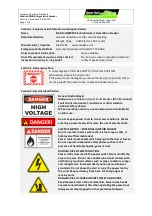
-52-
Model G0726 (Mfg. Since 7/11)
Gibs are tapered lengths of metal between two
sliding surfaces. Gibs control the size of the gap
between these surfaces, which affects how accu-
rately they slide. Correctly adjusting the gibs is
critical to producing good milling results.
Tight gibs make table movement more accurate
but stiff. Loose gibs make moving the table sloppy
but easier to do. The goal of gib adjustment is to
remove unnecessary sloppiness without causing
the ways to bind.
There is a screw on each end of the gib that can
be rotated to increase or decrease the friction
between the sliding surfaces. The process of
properly adjusting the gibs requires trial-and-error
and patience.
DISCONNECT MILL FROM POWER BEFORE
ADJUSTING THE GIBS!
Make sure all table and knee locks are loose and
that the table is centered on the saddle. Then,
loosen one gib adjustment screw and tighten the
other the same amount to move the gib. Use the
handwheels/crank to move the table/knee until
you feel a slight drag in that path of movement.
Note: It may be necessary to remove small parts,
such as way wipers and covers, to access the gib
adjustment screws.
The table (X-axis) has one gib located under the
front of the table (see
Figure 69).
Adjusting Gibs
The saddle (Y-axis) has a gib on both sides (see
Figure 70).
The knee (Z-axis) has three gibs—two on either
side of the left column dovetail way and one on
the right dovetail way (see
Figures 71–72).
Figure 71. Knee gib screws (2 of 6).
Gib
Screws
Figure 69. Table gib screw (1 of 2).
X-Axis Gib Screw
(1 of 2)
Figure 70. Saddle gib screws (1 of 4).
Y-Axis Gib Screw
(1 of 4)
Figure 72. Knee gib screw (1 of 6).
Gib
Screw
















































